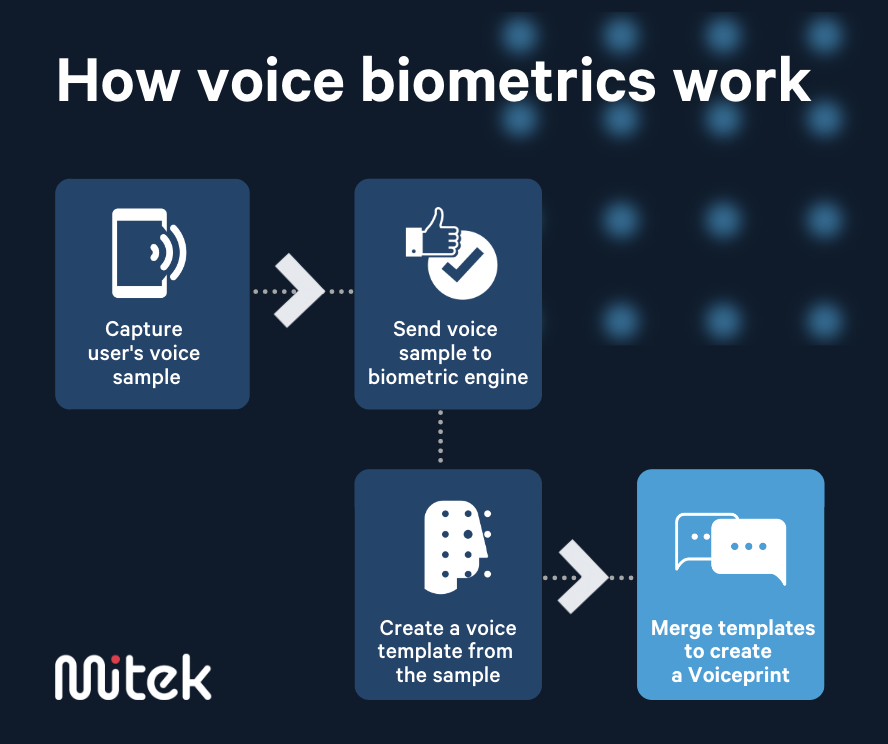Digital identity verification technology provider Mitek, explores why an increasing number of businesses are adopting voice biometrics authentication.
Recent technology advances have proven to be a double-edged sword. AI algorithms help with everything from cancer screenings to wildlife conservation. Yet, the same tools that enable positive life-changing experiences can also provide fraudsters new tools and capabilities. For example, the methods used for identity theft are becoming increasingly sophisticated. Malicious actors can combine personally identifiable information (PII) from various sources to create a synthetic identity or use deepfakes to mimic real people.
To stay one step ahead of fraudulent actors, organizations are turning to biometric authentication as the next evolution of identity security. Each time someone opens their smartphone with a face identification tool, they’re using facial recognition software, a form of biometric authentication.
Other companies have begun to use behavioral biometrics, which analyze user behavior patterns, like mouse clicks or account-login frequency to identify potentially fraudulent behavior. These tools add layers to identity-verification processes, making it harder for criminals to impersonate others.
Another form of biometric authentication is also becoming increasingly popular. Voice biometrics use an algorithmic template of a person’s voice to authenticate their identity and, like other biometric modalities, provide a more robust way to verify someone is who they say they are. Especially as the technology behind voice biometrics evolves, more organizations can consider adding voice authentication to their identity-proofing arsenal to replace outdated authentication methods like usernames & passwords.
How do voice biometrics work?
Have you ever set up a voice-activated personal assistant? That’s voice biometrics in action. When you first record your voice, you’re allowing Siri or Alexa or other virtual assistants to capture a sample of your voice. Behind the scenes, the voice assistant uses a litany of algorithms to create a biometric engine. Once recorded, your voice makes its way through that engine, allowing the voice assistant to make an initial “enrollment” voice template, or a “voiceprint” from your recorded sample.
Many voice biometric tools today combine several templates from your speech to improve recognition accuracy. The next time you unlock your phone through speech, the biometrics engine captures a new sample and compares it against the enrollment template. This identity-authentication method is known as “speaker verification.” Speaker verification creates a one-to-one match between the sample you give in real time and your enrollment template. By matching the two samples, the engine verifies that you are you.

Another way that biometrics engines use voice recognition is through “speaker identification,” a one-to-many arrangement. The speaker identification process compares a voice sample from an unknown person to multiple enrollment voiceprints. The process works by matching the speaker’s voice sample to one of a set of voice templates.
Speaker identification is a bit trickier for every business to use, as there are limits to its accuracy. However, advancements in AI and its underlying technologies are improving the accuracy of both one-to-many and one-to-one voice biometrics engines.
Voice biometrics engines work because they use unique physiological qualities, like speech patterns, to prevent identity fraud. Unlike authentication methods like passwords or PINs, voice authentication tools don’t rely on inputs, such as a secret code. Instead, this layer of security authenticates who is speaking.
There are a number of inherent benefits to using voice biometrics. It’s much harder for fraudsters to imitate someone else when they need a consistently accurate voice recording. Voice biometrics cannot be forgotten or stolen. And voice biometric authentication provides heightened security without compromising on the customer experience, because it provides a simple and intuitive usage pattern. As with any technological solution, voice biometrics comes with its own challenges, but companies that approach voice biometric technology thoughtfully can shore up their data security protocols and improve the customer experience at the same time.
Voice recognition – a shoo-in for security best practice
Voice biometrics provide a strong defense against conventional fraud vectors. However, implementing biometrics as a customer authentication method requires understanding that fraudsters also have access to the same advancements in artificial intelligence and voice verification.
Advances in machine learning and recording technology have made voice biometrics more convenient, in part by reducing the length requirements of voice samples and increasing recognition accuracy. Criminals are also tapping into those innovations to create high-quality deepfakes that mimic a human voice and can trick both humans and voice matching engines alike.
The good news is that speech-recognition technology integrates well with other forms of identity verification, like liveness detection which uses a separate set of algorithms to analyze whether the audio source is live or reproduced. Combining voice biometrics with liveness-detection technology helps improve identity recognition by distinguishing between a live human voice and a recorded or synthetic version of someone’s voice.
One other challenge to widespread voice biometric authentication is that it isn’t ideal for all environments, since ambient noises can impact the quality of the sample and the engine’s ability to match that sample accurately. Still, technological advancements, all-to-frequent password and credential data breaches, and customer expectations for a smooth customer experience are paving the way for security tools like voice biometrics to become commonplace soon.
A smooth customer experience with voice biometrics authentication
Although companies must implement voice biometric authentication alongside other modalities, like liveness detection, this form of biometric security is still a vast improvement over traditional password and credentials-based security. Voice-recognition biometrics are more secure than passwords and they improve data security while simultaneously removing friction from the customer experience.
Consider a typical multi-factor login experience. You enter your password, and then the service provider asks you to answer a security question, or enter a one-time code sent to your mobile device. The reality is that fraudsters can easily find personal information online which can be used to guess the answers to common security questions, like your mother’s maiden name, or the first street you lived on. They can also intercept one-time passcodes, or even clone your mobile device with SIM card swaps. In addition, these step-up techniques slow down the customer login experience, and do nothing to mitigate the risk of the actual credentials being forgotten, misplaced, or stolen.
Incorporating a voice biometrics solution into the customer authentication process removes friction from the customer experience and fits in nicely with current customer preferences.
Consider that 63% of customers called service providers last year and prefer calling over all other customer-service channels. Younger customers in particular are used to issuing voice commands to many of their devices. In the United States, 46% of people believe biometric identifiers have improved their lives.
Companies are clamoring for new ways to create seamless customer experiences built around these preferences. Nearly seven in 10 organizations want to allow digital customer verification and shopping history without using live agents, but only 38% can currently do so. So why not make voice recognition the heart of customer-service conversations? Voice biometrics can improve data security, create a seamless experience, and allow companies to meet customers where they’re comfortable: having conversations.
Mitek launching MiPass with advanced biometric authentication
For most organizations the question of voice biometrics is one of “when?” rather than “if?” Forward-thinking companies can begin integrating biometrics into their user interactions today to get ahead of the competition.
If you’re one of those forward-thinking companies, Mitek’s MiPass solution offers multi-modal passwordless authentication using face and voice biometrics for a myriad of use cases. MiPass uses a sophisticated combination of biometrics that are extremely difficult to falsify – face recognition, voice verification, and liveness detection — to strengthen trust in your customers’ real-world identities. MiPass can help you increase security and customer experience by replacing passwords and one-time passcodes with biometric authentication that you can easily embed into your existing platforms and customer workflows.
___________________________________________________________________
Mitek will be sponsoring the Future Identity Festival 2022, co-located with the Fintech Talents Festival on the 14th – 15th November, at The Brewery, London.
Join 2000 festival-goers as we explore the trends and technologies shaping the future of financial services. World-class learning and engagement, meets live entertainment and our famous craft beer bar, all while connecting with the industry players you are looking to meet. Book your place now!

